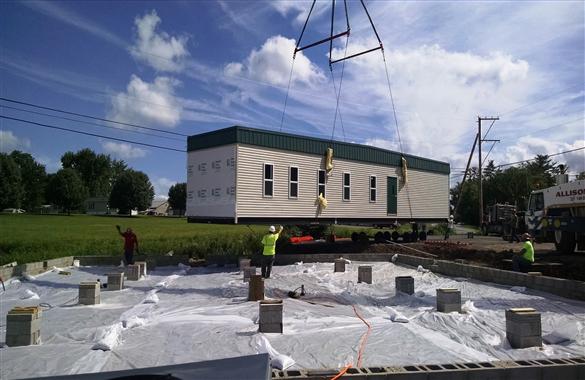The use of offsite or modular construction for industrial and commercial buildings has grown in popularity due to its speed of completion, technical innovation, cost effectiveness, energy efficiency and environmental sustainability.
Modular buildings are designed, engineered and fabricated in a factory-controlled environment to the buyer’s architectural specifications using traditional assembly line methods. They can be tens of thousands of square feet in area with single or multiple stories and are compatible in any environment.
When approximately 90% complete, modules are transported to the building site and erected in sections on an already prepared foundation, like building blocks. They have been engineered so that stairwells, water lines, power lines, HVAC, and other systems are already in place when they leave the factory.
Once they are set in place, interior and exterior finishing work is done, and the building(s) can be ready for occupancy in 30-50% less time than a traditional stick-built building.
Today’s modern modular buildings are ideal for use as office buildings, health care centers, dormitories, warehouses, churches, classrooms and complete campuses, retail space, industrial storage, machine rooms, equipment shelters, press boxes for stadiums, and hundreds of other temporary or permanent applications.
The design and construction expertise of today’s industrial and commercial modular builders are evident in the annual Awards of Distinction for the year’s best modular buildings from the Modular Building Institute, such as:
- Education: An innovative modular design by Modular Genius for the 7,200 SF Barrie School research learning lab in Silver Spring, MD, involved tall ceilings, moveable walls and lots of windows. The eco-friendly structure was built from reclaimed materials and recycled post-consumer products, and includes non-toxic paints and an elaborate waste water management system. The project was completed in 121 days.
- Equipment storage: Factory built construction was an ideal option for the modular fire protection equipment buildings at a remote solar facility in California’s Mojave Desert which had to be installed in tight spaces with limited access. The 2,600 SF facilities were installed at the site by means of a 40-ton crane with a 100 ft. boom and completed in 86 days.
- Emergency response center: The construction speed and financial advantages of utilizing modular construction enabled Columbia County in St. Helens, OR to replace structurally inadequate accommodations for their police and emergency operations center. The 1,792 SF structure, which also contains shower and kitchen facilities, was completed in 75 days.
Why Build Modular?
Some of the advantages of modular construction compared to conventional construction methods include:
- Adaptable to any site and environment
- Constructed with the same or better building materials to more demanding tolerances
- Meet or exceed local building, safety and occupancy codes
- Quality control overseen by in-house and 3rd Party licensed inspectors for the specific state of destination
- Lean manufacturing process reduces waste
- Lower environmental impact on job site from pollution, dust, noise
- Set-up and delivery-date certain
- 30-50% faster completion of entire project
- 20% cost savings on average
- Designed to be taken apart and reused rather than demolished
- Useful life of over 50 years with minimal maintenance
When the time comes to expand your current space or replace an aging building that requires too much maintenance, industrial and commercial modular buildings can help you save money on construction costs without sacrificing design and quality.

